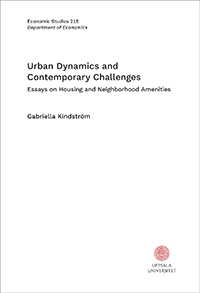New thesis: High construction pace has positive effects for low-income households

On June 10, Gabriella Kindström defended her thesis Urban Dynamics and Contemporary Challenges: Essays on Housing and Neighborhood Amenities.

Gabriella Kindström. Foto: Mikael Wallerstedt.
The thesis deals with contemporary urban challenges in a Swedish context. In four articles, Gabriella explores themes such as housing inequality, gentrification and residential segregation.
In the first article, Kindström investigates how the construction of new housing affects the distribution of housing between different income groups. While it is primarily high-income earners who move into newly produced housing, the relocation also makes housing available for low-income earners. As the homes age, they become more accessible to individuals with lower incomes and after about 30 years the income distribution is even.
Kindström shows that in municipalities with a higher construction rate, all income groups have better access to newer housing and larger living space. The conclusion is that new homes, even those that are initially primarily inhabited by high-income earners, lead to a relocation in the housing stock that also benefits low-income earners.
In the second article, Kindström examines whether large-scale housing construction can revitalize poorer neighborhoods. The results show that new large projects with market-rate condominiums not only lead to a 15 percent increase in average income in the poorest quartile of neighborhoods, but also a 10 percent increase in average income in existing housing. The increase in income in existing homes indicates an increase in the attractiveness of the area. Since new homes not only increase the housing supply but can also affect, for example, the district's service supply, the effect on housing prices is ambiguous.
In the third article, Kindström analyzes the effects of new housing by looking at housing prices in the area. The results show a price increase in low-income areas and a decrease in high-income areas, possibly due to densification.
In the fourth article, the effects of schools on residential areas are examined by studying school closures. With the help of geocoded Swedish microdata for the entire population, Kindström has been able to show that school closures reduce the proportion of high income earners, mainly among people with children. This effect is more pronounced in cities, while rural areas are depopulated, suggesting that school closures increase both residential segregation and rural depopulation.

